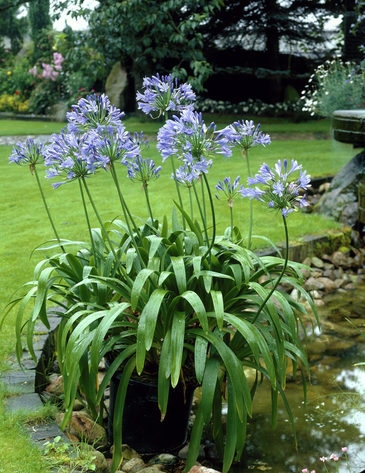Seasonal Agapanthus Care: Planning For Winter Months and Summer season
Seasonal Agapanthus Care: Planning For Winter Months and Summer season
Blog Article
Grasping the Art of Agapanthus Care: Vital Actions for Healthy Growth and Vibrant Flowers
In the world of horticulture, the growing of agapanthus stands as a rewarding endeavor for those who look for to nurture these sophisticated flowering plants. From selecting the appropriate range to grasping pruning techniques, the trip towards cultivating thriving agapanthus plants is diverse and holds the key to opening the full potential of these herb gems.
:max_bytes(150000):strip_icc()/agapanthus-growing-guide-7368912_04-66a3f4cf245b4332b28954dd37c784f5.jpg)
Choosing the Right Agapanthus Variety

When selecting the appropriate Agapanthus selection for your garden, consider variables such as climate suitability, flower shade, and growth routine. In addition, take into consideration the climate in your area to make sure the Agapanthus selection you pick can flourish in your details conditions. Recognizing the growth practice of various Agapanthus varieties is important for correct placement within your garden.
Ideal Growing Problems
Considering the ideal environmental needs is essential for successful Agapanthus farming. Agapanthus grows in well-draining dirt with a slightly acidic to neutral pH level. When planting, pick a location that gets complete sunshine to partial shade. In hotter environments, providing some afternoon color can stop scorching of the fallen leaves. Agapanthus plants are sensitive to chilly temperature levels and should be protected from frost throughout winter season.
To make certain healthy development and lively flowers, plant Agapanthus bulbs at a deepness of about 2-4 inches and space them 8-12 inches apart. Mulching around the base of the plants aids keep moisture and reduces weed growth.
Watering and Fertilizing Tips
Maintaining correct wetness degrees and providing essential nutrients are vital components in the care routine for Agapanthus plants. When it comes to watering Agapanthus, it is vital to strike a balance. These plants choose constantly moist soil but are at risk to root rot if overwatered.
Fertilizing Agapanthus is vital for promoting healthy development and respected blossoms. Use a balanced plant food, such as a 10-10-10 formula, in the very early springtime as new get more growth arises. By adhering to these watering and fertilizing pointers, you can guarantee your Agapanthus plants thrive and create dynamic, lasting flowers.
Trimming Techniques for Agapanthus
Pruning Agapanthus plants at the ideal times and with proper methods is critical for maintaining their wellness and promoting optimum development and blooming. The excellent time to prune Agapanthus is in late wintertime or very early springtime prior to brand-new development arises.
Deadheading spent blossoms can likewise redirect the plant's energy into producing even more flowers rather than establishing seeds. If you desire to accumulate seeds for breeding, leave some blossoms to completely dry and mature on the plant.
Bear in mind to make use of tidy, sharp tools to make accurate cuts and reduce the risk of introducing conditions. Agapanthus. Routine pruning will aid keep your Agapanthus looking neat and healthy while making sure a plentiful screen of stunning blossoms
Handling Typical Parasites and Diseases
After making sure proper pruning techniques for Agapanthus, it is important to attend to typical insects and diseases that can influence the health and vitality of these plants. Agapanthus plants are normally durable but can still drop sufferer get more to specific issues. One typical bug that influences Agapanthus is the Agapanthus gall midget. This tiny, orange fly lays its eggs in the vegetation, resulting in altered growth and blossom buds that fall short to open. To combat this pest, trim and damage any type of damaged plant parts and take into consideration making use of insecticidal soap.
In addition, Agapanthus plants can suffer from origin rot if they are planted in inadequately draining soil. By being attentive and taking prompt activity against illness and parasites, you can assist your Agapanthus plants prosper and create lively blossoms. Agapanthus.

Conclusion
Finally, mastering the art of agapanthus care entails choosing the ideal variety, visit this page providing ideal growing conditions, correct watering and feeding, ideal trimming strategies, and addressing common parasites and illness. By following these vital steps, you can make sure healthy and balanced development and lively blooms for your agapanthus plants. Bear in mind to routinely keep track of and preserve your plants to advertise their total health and long life.
To make certain healthy growth and vibrant blooms, plant Agapanthus bulbs at a deepness of about 2-4 inches and room them 8-12 inches apart. By adhering to these watering and feeding ideas, you can guarantee your Agapanthus plants prosper and generate dynamic, lasting flowers.
One usual pest that influences Agapanthus is the Agapanthus gall midge. Additionally, Agapanthus plants can experience from origin rot if they are grown in improperly draining pipes dirt. By adhering to these important actions, you can ensure healthy development and vivid blooms for your agapanthus plants.
Report this page